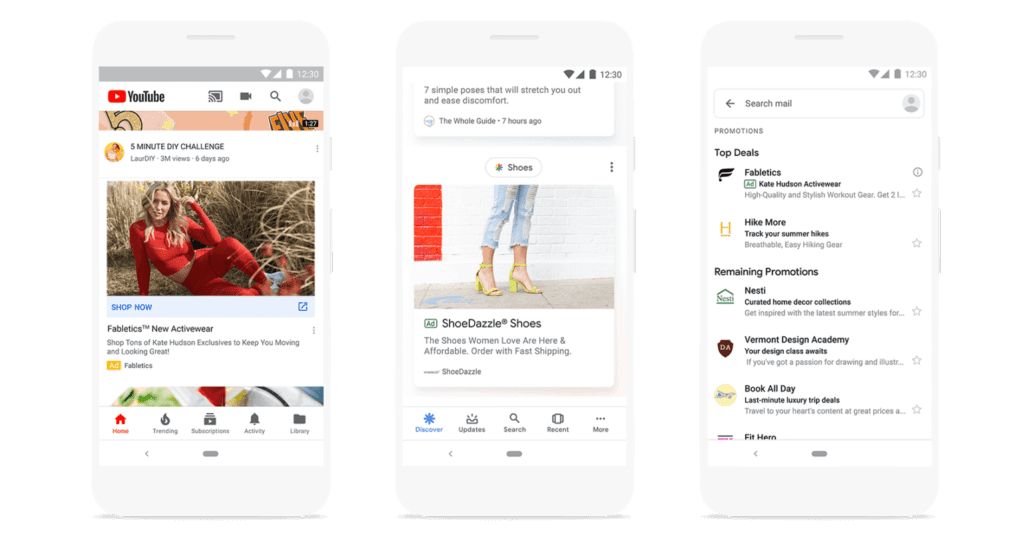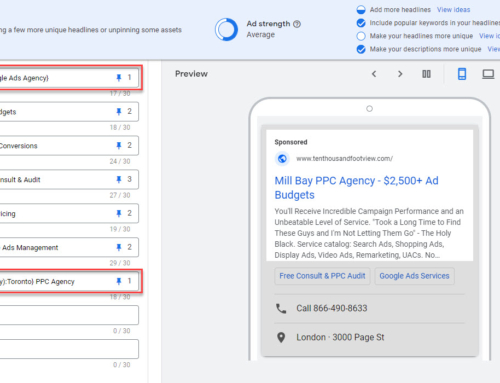Discovery Ads were announced way back in May 2019, and have just been launched for all advertisers. We’ve been working with Discovery in closed-beta and open-beta for the past 6-months.
In this article, I’m going to walk you through how to create and optimize your own Discovery Ads campaign.
What are Discovery Ads?
To understand Discovery Ads you must first understand Google’s display inventory. Google has offered display ads for many years. For the most part, these ran on publisher sites participating in Google’s AdSense affiliate program. On this network, called GDN (Google Display Network), publishers are paid part of the revenue for ad clicks.
More recently (several years), Google added apps and videos to the GDN. Importantly, all of this ad “inventory” is hosted or provided by third parties.
For a few years now, Google Ads users have been able to advertise on the Gmail app for mobile and desktop devices. Gmail inventory is fundamentally different since it belongs to Google and is managed through its own sub-campaign type.
About a year ago Google rolled out more Google controlled inventory in Beta. This included the YouTube Discovery page and Google’s Newsfeed App content.
Discovery Ads are display ads run exclusively on Gmail, YouTube Discovery, and Google’s Newsfeed placements. Traditional display campaigns don’t have access to this inventory. You can still run Gmail specific campaigns as mentioned above, but I believe this campaign type will be discontinued soon.
Why Discovery Instead of GDN?
Because Discovery runs exclusively on Google’s inventory there are quite a few benefits over the GDN.
- Inventory quality is much higher than the GDN, with better contextual relevance and user engagement
- There is absolutely no chance of click fraud, which depending on who you believe, is a huge problem on the GDN
- Fully automated placement targeting eliminates much of the complexity of campaign creation and optimization
- Easy to build creatives similar to Responsive Display Ads, no banners to worry about
- You don’t have to build and manage a separate Gmail campaign
In a nutshell, the return on investment is typically much higher for Discovery Ads than traditional display. In addition, campaign development and optimization is a snap compared to the GDN.
Downsides of Discovery Ads
As great as Discovery Ads are, there are some issues with them.
- Discovery Ads only offer Maximize Conversions or tCPA bidding options, which is not appropriate for branding
- Inventory is very limited compared to GDN, don’t expect to see a huge volume of clicks or conversions
Building Your First Campaign
Campaign creation follows the usual practice. Choose your campaign goal or bypass that with the “without a goal’s guidance” option and choose the Discovery campaign type.
The first thing you’ll probably notice about campaign settings as there are far fewer options than display or search campaigns.
Go ahead and complete the basic campaigns settings as follows:
- Campaign name
- Locations
- Languages
- Bidding & Budget (a note on this below)
- Ad Schedule, start/end dates
- Campaign URL options (add your UTM tags here)
- Conversions (adjust which conversion goals to include as appropriate)
With respect to bidding, you may either choose Max Conversions or tCPA. It’s important to choose the right strategy here. If you want to consistently hit your budget and are okay with a variable CPA, choose Max Conversions. If you want to achieve a fixed CPA and are okay not always spending your budget, you should choose the tCPA option. Note that if you choose tCPA, I recommend setting it to what Google recommends to start. Alternatively, choose a tCPA that’s at least 30% higher than your paid search average.
If you choose tCPA bidding, you should set a daily budget that is at least between 5-10x as much as your tCPA. This assists automated bidding to learn quickly and get your conversions ramped up quickly.
Target Audiences & Demographics
It’s highly unlikely your campaign will be successful if you try to run it wide open to all possible people in your target area. This, after all, isn’t a “Smart” campaign type.
Outside of uploaded lists, most audience types are available. We’ve found the most success in terms of CPA running remarketing, custom intent, and in-market audiences, and in that order. However, that’s not to say that other audience types won’t work from you.
Unless you’re a GDN expert, I’d start with remarketing, and work your way up the funnel slowly over time. Keep in mind that you must have a substantially large remarketing list (recommend 5,000+ users) and national targeting to get much traction from GDN. As a general rule, it’s usually best to separate remarketing into its own campaign, and other audiences into their own ad groups.
As for demographics, you can choose whether to target or not target different groups, there are no bid adjustments available. Unless you’re absolutely sure a particular audience segment is undesirable, we usually target everybody.
Demographics options include age, gender, parental status, and household income (some markets only).
Ad Groups & Ads
I recommend using separate ad groups for substantially different offers or different target audiences as described above. The main benefit here is the ability to set a different tROAS for each ad group.
Discovery Ads uses custom creatives that work similarly to Responsive Display Ads. You have two options here with a Discovery Ad (promotes one product or service) or Discovery Carousel Ad (promotes up to 10 products or services with an interactive interface).
Discovery Ads allow for multiple headlines, images and logos, descriptions, and calls to action. Google will test different combinations and self-optimize for the best performing version over time.
Discovery Carousel Ads allow you to create a single overall headline and description and present individual product or service details which users can scroll through.
Optimizing Discovery Ads
Once you launch you should give your campaign about a week to stabilize. By day 7 you’ll typically find that you’re either hitting your budget cap or not serving ads much at all.
If you’re hitting your budget cap that’s good, it means you’re probably seeing some conversions too. Assuming both are true you can sit on the campaign for now, or consider raising your budget some to drive more conversions.
However, if you’re hitting your budget cap and haven’t generated any conversions you have some issues to deal with. In this situation, you’ve obviously chosen the Max Conversions bidding method. Given that I recommend refining your target audience to be more specific. This may include removing some higher up-the-funnel audiences, modifying custom intent audiences, or blocking out some less desirable demographics.
If you’re not spending much it’s likely that your target audience is too small, your tCPA is too aggressive (low), or your budget is too small relative to your tCPA. Consider adding more audiences, particularly ones that are larger and/or higher up the funnel. Try increasing your budget to at least 5x of your tCPA. Consider switching to a Max Conversions model for a while to see if that gets your campaign spending.
The other thing to consider is reworking your creatives. Unfortunately, Google doesn’t yet provide insights on individual copy or images per ad. It’s likely Google will roll this out at some point so keep an eye out for that.
Summary
Discovery Ads are the best solution for your first foray into Google display ads. Unlike the GDN, your ads will run only on premium Google inventory. Furthermore, you won’t have to worry about contextual targeting with keywords or topics as Google takes care of that for you based on user behaviour and content. Finally, creatives can quickly and easily be built up from snippets of ad copy and imagery.
Getting a steady stream of conversions with Discovery Ads isn’t a slam dunk, but your chances are way better than with the GDN.
What are you waiting for? Start building your first Discovery campaign today.






